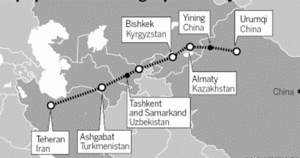In the post sanctions Iran, China surely seems to have edged past other countries in grabbing the first mover advantage. Recently, Chinese President Xi Jinping became the first foreign leader to visit Iran after the Western sanctions were lifted from the country. It was also the first state visit in 14 years by a Chinese head of state to Iran.[1] The visit was a diplomatic and economic success for both the sides. 17 agreements covering diverse sectors like energy, industrial capacity, finance, investments, judiciary, culture, science and technology, media, human resources and climate change were signed between the two sides.[2] They also agreed to increase bilateral trade by more than ten times to USD 600 billion in next decade.
The agreements also included revival of ancient Silk Route.[3] China has been Iran’s biggest trade partner since 2009 and helped Iranian economy stay afloat by buying oil during the sanctions period. It was China that helped Iran kick start its nuclear program in 1980s.[4] China has been a traditional weapons supplier to Iran due to Tehran’s rift with the US. Their anti-US stance continues to bind them even after Iran nuclear deal. Iran’s supreme leader Ayatollah Ali Khamenei told President Xi Jinping during the visit that “Iranians never trusted the West…. That’s why Tehran seeks cooperation with more independent countries” (like China).[5]
Iran remains central to China’s Middle East policy due to a number of reasons. Iran has no involvement in China’s internal affairs (Xinjiang), unlike Saudi Arabia. China fears links between Saudi Arabia and Uighur separatists in its restive autonomous province of Xinjiang. Iran’s geography bordering on the Caucasus, Central Asia, Turkey, and the Middle East makes it a far more important link than Saudi Arabia in China’s Silk Road plans.[6] Iran is a neighbor of Pakistan where China is building Gwadar port and investing USD 46 billion in the CPEC. Lastly, China sees Iran as a country that can play a crucial role in China’s New Silk Road initiative; given its access to extensive delivery routes connecting to the Middle East and Eurasia.[7] All these factors together make Iran a strategic ally for China in Middle East.
The Silk Road project seems on the fast track. China flagged off its first direct freight train to Iran from the trading hub of Yiwu on January 29, 2016. The train is the first regular container train linking China to the Middle East covering a journey of 10,399 km in 14 days.
Source: www.eurasiabusinessbriefing.com
After leaving China from western city of Yiwu through the northwestern province of Xinjiang, it passed through Kazakhstan and Turkmenistan before heading for the Iranian capital in two weeks.[8] Compared to the railway option, cargo ships, setting sail from Shanghai take nearly 45 days to arrive at the Iranian port of Bandar Abbas.[9]
Historically, Iran was prevented from having a railroad by Anglo-Russian rivalry until the late 1920s, and because of the rise of the Soviet Union it was cut off from its traditional markets in Central Asia. However, China will bring railways in a big way not only to Iran but also to Central Asia. This initiative will further link Iranian market to Europe through Turkey and would also open Central Asian markets for Iran.[10]
India has its own plans to connect to Central Asia and Europe through Iran. However, it should support Chinese Silk Road projects in Iran (not the whole Silk Road project) and seek ways to cooperate with China in Iran. This will not only ensure that India does not face unnecessary competition from China in Iran’s now crowded and competitive market but will also make sure that India has alternate access to European and Central Asian markets.
Endnotes
[1] Xi arrives in Iran for state visit, Jan 23, 2016, Xinhua http://news.xinhuanet.com/english/2016-01/23/c_135037242.htm
[2] Iran and China sign agreements to broaden bilateral cooperation, http://desicritics.org/news/current-affairs/iran-china-sign-agreements-broaden-bilateral-cooperation/4002
[3] Suwatchai Songwanich (2016), “President Xi makes a strategic visit to Middle East”, Feb 1, http://www.nationmultimedia.com/opinion/President-Xi-makes-a-strategic-visit-to-Middle-Eas-30278205.html
[4] Owen Matthews (2016), “China: Iran’s New Best Friend”, Newsweek, Feb 1, http://www.newsweek.com/china-irans-hassan-rouhani-xi-jinping-421614
[5] Helen Wang (2016), “Xi Jinping’s Mideast Trip to Push One Belt One Road”, Jan 30, http://www.forbes.com/sites/helenwang/2016/01/30/xi-jinpings-mideast-trip-to-push-one-belt-one-road/#785441414f27
[6] James Dorsey (2016), “China & the Middle East: Tilting Towards Iran?”, Jan 28, http://www.huffingtonpost.com/entry/china–the-middle-east-ti_b_9098224.html?section=india
[7] Saeed Kamali Dehghan (2016), “China’s Silk Road revival steams ahead as cargo train arrives in Iran”, Feb 15, http://www.theguardian.com/business/2016/feb/15/chinas-silk-road-revival-steams-ahead-as-cargo-train-arrives-in-iran
[8] First ‘Silk Road’ train in Tehran after 14-day journey from China, Feb 15, http://www.presstv.ir/Detail/2016/02/15/450491/iran-Silk-Road-train-china-train-freight
[9] Atul Aneja (2016), “Iran in the Belt and Road loop as first train from China arrives”, The Hindu, Feb 16, 2016, http://www.thehindu.com/news/international/iran-in-the-belt-and-road-loop-as-first-train-from-china-arrives/article8245236.ece
[10] Juan Cole (2016), “The Chinese are Coming: First ‘New Silk Road’ Train reaches Iran’s Capital”, Feb 17, http://www.juancole.com/2016/02/the-chinese-are-coming-first-new-silk-road-train-reaches-irans-capital.html


